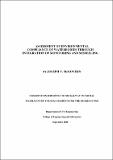| dc.contributor.advisor | Hartnett, Michael | |
| dc.contributor.author | McGovern, Joseph Vincent | |
| dc.date.accessioned | 2017-01-27T11:15:02Z | |
| dc.date.available | 2017-01-27T11:15:02Z | |
| dc.date.issued | 2016-09-30 | |
| dc.identifier.uri | http://hdl.handle.net/10379/6270 | |
| dc.description.abstract | Design of water quality monitoring networks in estuarine and coastal waters is hampered by a lack of a clear methodology. Monitoring networks are designed on an ad-hoc basis supported by experts in the area. Guidance on the design of monitoring networks focuses on inland surface and ground water, with little thought given to the highly dynamic estuarine environment. Monitoring data from the marine environment may be used for assessment purposes or in the detection of an emerging trend. Numerical models may be used to assist in the understanding of underlying processes and predict the outcome of management options. However, high resolution numerical models are not directly used as a proxy for monitoring data.
Entropy analysis theory has been applied to monitoring data and numerical model water quality simulation data at Cork Harbour in order to prioritise the existing monitoring network and establish the optimum monitoring network with respect to spatial and temporal coverage for Chlorophyll_a, molybdate reactive phosphorus and dissolved inorganic nitrogen. The same method has been applied to rank all 30x30m grid cells used in the numerical model. The optimised monitoring networks returned the same trophic status for each of the seven water bodies in Cork Harbour as were returned by the current monitoring programme adopted by the Irish EPA.
To address any perceived shortcoming in redesigning monitoring networks and in order to utilise a calibrated and validated numerical model to supplement the monitoring network, the Bayesian Maximum Entropy method of geostatistical estimation was tested on the proposed optimised monitoring networks. Estimates of the timeseries at removed monitoring points were generated using monitoring data from the retained monitoring network in addition to numerical model outputs. Using the water quality data estimates and monitoring data from the retained network yielded the same trophic compliance status that would be returned were all monitoring points retained. Leave-one-out cross validation of daily averaged monitoring data proved that BME or kriging could be adopted to derive probability density functions of values across Cork Harbour in each constituent waterbody with a high level of confidence.
A framework proposal was suggested whereby a reciprocal arrangement could be adopted of improvement of numerical model accuracy would assist in the ongoing optimisation of the monitoring network, the results of which would be used to re-calibrate and validate the numerical model on an ongoing basis as and when new information would come to light. | en_IE |
| dc.rights | Attribution-NonCommercial-NoDerivs 3.0 Ireland | |
| dc.rights.uri | https://creativecommons.org/licenses/by-nc-nd/3.0/ie/ | |
| dc.subject | Estuary | en_IE |
| dc.subject | Covariance | en_IE |
| dc.subject | Water quality | en_IE |
| dc.subject | Monitoring network design | en_IE |
| dc.subject | Bayesian maximum entropy | en_IE |
| dc.subject | Water quality model | en_IE |
| dc.subject | Civil engineering | en_IE |
| dc.title | Assessment of environmental compliance of waterbodies through integration of monitoring and modelling | en_IE |
| dc.type | Thesis | en_IE |
| dc.contributor.funder | Environmental Protection Agency | en_IE |
| dc.local.note | An estuarine trophic monitoring network design methodology was proposed and validated, using a water quality model and monitoring data. Trophic status of estuaries was not compromised by methodical downsizing of the existing monitoring network, either with or without supplementary geostatistical estimates derived from water quality data and model simulation data. | en_IE |
| dc.local.final | Yes | en_IE |
| nui.item.downloads | 445 | |


